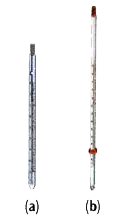There is a kink or bend in the stem of a clinical thermometer
Step-by-Step Solution:
1. Understanding the Structure of a Clinical Thermometer:
A clinical thermometer is designed to measure body temperature. It consists of a glass tube with a bulb at one end filled with mercury.
Hint: Think about the parts of a thermometer and their functions.
2. Identifying the Kink:
The kink or bend in the stem of the thermometer is located near the bulb. This feature is crucial for the thermometer's operation.
Hint: Consider why a bend might be necessary in a measuring instrument.
3. Function of the Kink:
The primary purpose of the kink is to prevent the mercury from flowing back into the bulb when the thermometer is removed from the mouth or the area being measured. This ensures that the reading can be taken accurately.
Hint: Reflect on what happens if the mercury were to return to the bulb immediately after removal.
4. Allowing Time for Reading:
The kink allows the mercury to stay in place for a moment, giving the user time to read the temperature without the mercury dropping back down.
Hint: Think about how this feature improves the usability of the thermometer.
5. Conclusion:
Therefore, the kink in a clinical thermometer is a vital design feature that ensures accurate temperature readings by preventing the mercury from returning to the bulb too quickly.
Hint: Summarize the importance of the kink in relation to the thermometer's function.
---
A clinical thermometer is designed to measure body temperature. It consists of a glass tube with a bulb at one end filled with mercury.
The kink or bend in the stem of the thermometer is located near the bulb. This feature is crucial for the thermometer's operation.
The primary purpose of the kink is to prevent the mercury from flowing back into the bulb when the thermometer is removed from the mouth or the area being measured. This ensures that the reading can be taken accurately.
The kink allows the mercury to stay in place for a moment, giving the user time to read the temperature without the mercury dropping back down.
Therefore, the kink in a clinical thermometer is a vital design feature that ensures accurate temperature readings by preventing the mercury from returning to the bulb too quickly.
Topper's Solved these Questions
- PHYSICAL QUANTITIES AND MEASUREMENT Book:ICSEChapter:PHYSICAL QUANTITIES AND MEASUREMENT Exercise:Exercises (Section II) Explain the following terms.
Explore 3 Videos
- PHYSICAL QUANTITIES AND MEASUREMENT Book:ICSEChapter:PHYSICAL QUANTITIES AND MEASUREMENT Exercise:Exercises (Section II) Distinguish between
Explore 4 Videos
- PHYSICAL QUANTITIES AND MEASUREMENT Book:ICSEChapter:PHYSICAL QUANTITIES AND MEASUREMENT Exercise:Exercises (Section I) Circle the odd one. One has been done for you.
Explore 5 Videos
- MODEL TEST PAPERS Book:ICSEChapter:MODEL TEST PAPERS Exercise:TEST PAPER II (SECTION II) Numerical questions
Explore 2 Videos
Similar Questions
Knowledge Check
A thermometer uses :
AwaterBmercuryCairDnone of the above
The upper and lower fixed points of a fualty thermometer are 5∘C and 105∘C. If the thermometer reads 25∘C, what is the actual temperature?
View SolutionThe steam point and the ice point of a mercury thermometer are marked as 80∘and10∘. At what temperature on centigrade scale the reading of this thermometer will be 59∘ ?
View SolutionThe steam point and the ice point of a mercury thermometer are marked as 80∘and10∘. At what temperature on centigrade scale the reading of this thermometer will be 59∘ ?
View SolutionAn arbitrary scale has the ice point at −20∘ and the steam point at 180∘. When the thermometer reads 5∘, then find the read of centigrade thermometer.
View SolutionDifferentiate between a laboratory thermometer and a clinical thermometer
View SolutionStatement-1: Clinical thermometers are made long and thin.
Staetment-2: Long and thin thermometers can easily be kept in mouth below the tongue.
View SolutionThe gas thermometers are more sensitive than liquid thermometers because gases
View Solution
